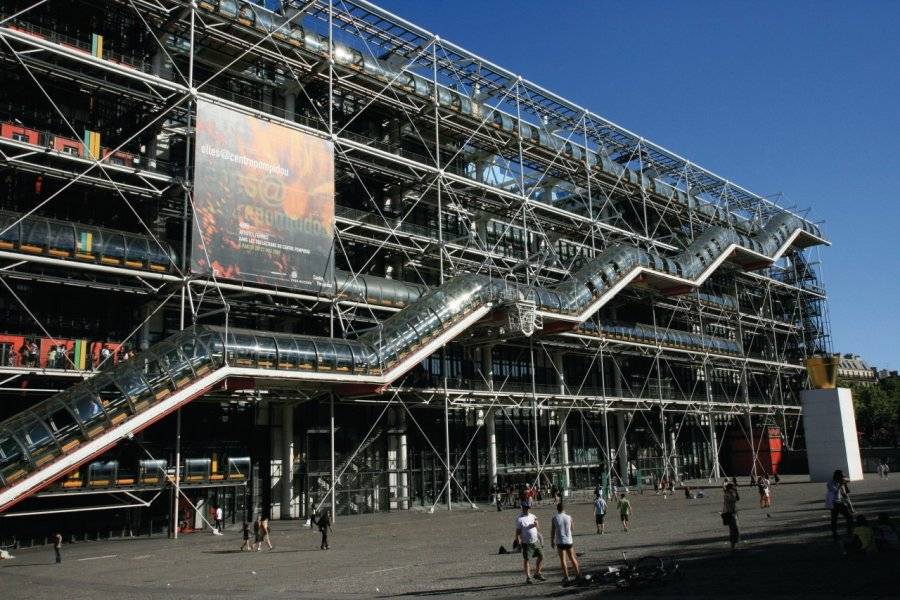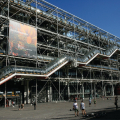MUSÉE NATIONAL D'ART MODERNE – CENTRE POMPIDOU
The Musée National d'Art Moderne in Paris presents personal objects by Renzo Piano, with tools, with discovery
The museum is housed on the4th and5th levels of the Centre Pompidou, with 12,210 m² of floor space. It boasts a collection of 120,000 works, the largest in Europe and the second largest in the world, after MoMA in New York. From this collection, 1,500 to 2,000 works are exhibited on a rotating basis. The presentation is chronological, allowing you to better understand the evolution of the visual arts over the last hundred years. Monographic and thematic rooms alternate to make the visit even more captivating. Level 5 of the center features works dating from 1905 to 1960. Level 4 picks up the thread and ends with contemporary art. This collection is constantly being enriched to keep pace with developments on the contemporary scene. On these floors, you'll find access to the halls hosting major temporary exhibitions that regularly explore a theme linked to the history of modern art or the work of a particular artist. Consult the program on the website. Last but not least, three terraces extend the museum's space, featuring imposing sculptures by Henri Laurens, Joan Miró and Alexandre Calder. A visit to the museum is almost mind-boggling, with so many masterpieces by painters and sculptors who have changed the way we look at the world. All the major currents and movements are represented: Fauvism (Derain, Matisse, Vlaminck, Dufy, Van Dongen, Rouault...), Cubism (Braque, Picasso, Léger, Gris, Gleizes...), Dadaism and Surrealism (Duchamp, Man Ray, Picabia, Magritte, Dalí...), Futurism (Boccaccio, Calderon...).), Futurism (Boccioni, Russolo, Magnelli...), Expressionism (Kirchner, Kokoschka, Dix...), the Paris School (Chagall, Modigliani, Soutine...), the various trends in abstract art (Kandinsky, Mondrian, Malevitch, Pollock, Rothko, de Kooning, Hartung, Soulages, Zao Wou Ki....), art brut or informel (Fautrier, Dubuffet, Tàpies, Chaissac...), Nouveau Réalisme (Arman, Klein, Tinguely de Saint-Phalle, César...), Pop Art (Warhol, Rauschenberg, Johns...), Fluxus (Beuys, Paik, Filliou, Ben...), Minimalism (Kandinsky, Mondrian, Malevitch, Pollock, Rothko, de Kooning, Hartung, Soulages, Zao Wou Ki...)....), minimalism (LeWitt, Serra, Stella, Buren, Morellet...), Arte Povera (Manzoni, Penone, Kounellis, Pistoletto...), narrative figuration (Adami, Cueco, Erro, Fromanger, Rancillac...)... It's impossible to mention them all! In addition to these artists, who often moved from one movement to another in the course of their career, we must also mention individuals as diverse as Rousseau, Signac, Delaunay, Klee, Giacometti, Arp, Rivera, Kahlo, Bourgeois, Bacon... These treasures are complemented by pieces illustrating the history of architecture and design during the same period (Le Corbusier, Mallet-Stevens, Prouvé, Loewy, Paulin, Garouste & Bonetti, Starck, Nouvel, de Portzamparc...). We'd now like to mention a few VIPs, or Very Important Pieces, as the museum likes to call them, and offer you a new visitor's itinerary that gives them pride of place, taking you on a journey of discovery of some of the most emblematic works of the 20th and 21st centuries. An interesting series of podcasts dedicated to these works is also available on the website, providing you with a wealth of information. Tip: to check in advance whether a painting is actually on display in the museum on the day of your visit (the reserves are gigantic and the collection is frequently renewed!), don't hesitate to consult the interactive map updated on the website. Among the museum's VIPs is the famous "Fountain" by Marcel Duchamp (1917/1964). Founder of the ready-made, Duchamp claimed that any object could be a work of art if the artist chose it. With a certain provocation, he decided to exhibit a urinal. Initially rejected by a New York salon, this work is now one of the most emblematic of the artist's work, which undoubtedly had a major influence on twentieth-century art. Other must-sees, or VIPs, include Vassily Kandinsky's "Mit dem schwarzen Bogen (With the Black Bow)", Henri Matisse's "La blouse roumaine", Marc Chagall's "Les mariés de la Tour Eiffel", Frida Kahlo's "The frame", Piet Mondrian's "New York City" and Fernand Léger's "Les Loisirs-Hommage à Louis David", "Triptych Bleu I, Bleu II, Bleu III" by Joan Miró, "SE 71, L'Arbre, grande éponge bleue" by Yves Klein, "Bildnis der Journalistin Sylvia von Harden" by Otto Dix, "Le jardin d'hiver" by Jean Dubuffet and "Precious Liquids" by Louise Bourgeois. The list goes on and on, so we recommend you allow at least half a day for your visit to the Musée national d'art moderne - Centre Pompidou. Be warned, however: from 2025 onwards, the Centre Pompidou will gradually close its doors for extensive renovation work, which will last no less than 5 years! The auditoriums will close in January, followed by the museum in March, and the exhibition spaces, bookshop and boutique in the summer! At the end of this period, a complete overhaul of the site - without touching its architecture - will give a new lease of life to this establishment, which in the meantime will have celebrated its 50th anniversary!
Did you know? This review was written by our professional authors.
The strengths of this establishment:
Members' reviews on MUSÉE NATIONAL D'ART MODERNE – CENTRE POMPIDOU
The ratings and reviews below reflect the subjective opinions of members and not the opinion of The Little Witty.


















Sinon la vue est cool.
建築物也非常有特色,很工業風、管線外露,與巴黎街頭十分不搭嘎,但看久了也是非常有特色。整體建築物也是非常大,我們看藝術品展出的地方也只佔其中一部分而已。
整體而言,對現代藝術有興趣的人,非常值得來欣賞~
(好像還有圖書館,有時候會看到大排長龍的人群,就是要排隊進入圖書館讀書的法國學子們)
Spero presto possano rimediare. Grazie